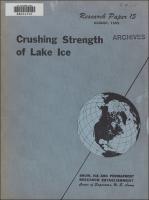Please use this identifier to cite or link to this item:
https://hdl.handle.net/11681/22897Full metadata record
| DC Field | Value | Language |
|---|---|---|
| dc.contributor.author | Butkovich, Theodore R. | - |
| dc.date.accessioned | 2017-09-01T17:33:08Z | - |
| dc.date.available | 2017-09-01T17:33:08Z | - |
| dc.date.issued | 1955-08 | - |
| dc.identifier.uri | http://hdl.handle.net/11681/22897 | - |
| dc.description.abstract | Tests were made to determine the effects of size of prismatic specimens, cross section, ratio of overall length to length of side of square section, types of ice, both natural clear ice and snow ice, orientation of c-axis, and size of candle. Rough-cut specimens were crushed in a 120, 000 lb capacity press. The results of the tests show that: ( 1) Larger-grained clear ice is stronger in compression. (2) Ice is stronger parallel to the ice sheet than normal to it. (3) Specimens of smaller cross-section have higher crushing strength. (4) Prisms with lower ratios of length to width are stronger. No effect of c-axis orientation was detected. | en_US |
| dc.language.iso | en | en_US |
| dc.publisher | U.S. Army Snow, Ice, and Permafrost Research Establishment. | en_US |
| dc.relation.ispartofseries | Research Paper;15 | - |
| dc.subject | Ice--Testing | en_US |
| dc.subject | Strength of materials | en_US |
| dc.title | Crushing strength of lake ice | en_US |
| dc.type | Report | en_US |
| Appears in Collections: | Research Report | |
Files in This Item:
| File | Description | Size | Format | |
|---|---|---|---|---|
| Research Paper 15.pdf | 5.42 MB | Adobe PDF |  View/Open |